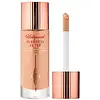What's inside
What's inside
 Key Ingredients
Key Ingredients

 Benefits
Benefits

 Concerns
Concerns

 Ingredients Side-by-side
Ingredients Side-by-side

Water
Skin ConditioningHydrogenated Didecene
Skin ConditioningMica
Cosmetic ColorantGlycerin
HumectantPropanediol
SolventSqualane
EmollientCetyl PEG/PPG-10/1 Dimethicone
EmulsifyingIsoamyl Laurate
EmollientHydrogenated Styrene/Isoprene Copolymer
Sodium Chloride
MaskingCaprylic/Capric Triglyceride
MaskingHydroxyacetophenone
AntioxidantPolyglyceryl-4 Isostearate
Emulsifying1,2-Hexanediol
Skin ConditioningCaprylyl Glycol
EmollientTrisodium Ethylenediamine Disuccinate
Hoya Lacunosa Flower Extract
Skin ConditioningPentaerythrityl Tetra-Di-T-Butyl Hydroxyhydrocinnamate
AntioxidantCI 77891
Cosmetic ColorantIron Oxides
CI 77163
Cosmetic ColorantWater, Hydrogenated Didecene, Mica, Glycerin, Propanediol, Squalane, Cetyl PEG/PPG-10/1 Dimethicone, Isoamyl Laurate, Hydrogenated Styrene/Isoprene Copolymer, Sodium Chloride, Caprylic/Capric Triglyceride, Hydroxyacetophenone, Polyglyceryl-4 Isostearate, 1,2-Hexanediol, Caprylyl Glycol, Trisodium Ethylenediamine Disuccinate, Hoya Lacunosa Flower Extract, Pentaerythrityl Tetra-Di-T-Butyl Hydroxyhydrocinnamate, CI 77891, Iron Oxides, CI 77163
Water
Skin ConditioningCaprylic/Capric Triglyceride
MaskingCI 77891
Cosmetic ColorantGlycerin
HumectantPolyglyceryl-3 Polyricinoleate
EmulsifyingNiacinamide
SmoothingAlcohol Denat.
AntimicrobialMagnesium Sulfate
Pancratium Maritimum Extract
BleachingRosa Rugosa Flower Extract
Skin ConditioningSodium Palmitoyl Proline
Skin ConditioningNymphaea Alba Flower Extract
Skin ConditioningTuber Magnatum Extract
Skin ConditioningHydrolyzed Vegetable Protein
Skin ConditioningMaltodextrin
AbsorbentStearalkonium Hectorite
Gel FormingCI 77492
Cosmetic ColorantDiisostearyl Malate
EmollientPolyglyceryl-3 Diisostearate
EmulsifyingAluminum Hydroxide
EmollientPolymethylsilsesquioxane
Stearic Acid
CleansingCI 77491
Cosmetic ColorantDisodium Stearoyl Glutamate
CleansingTriethoxycaprylylsilane
Ethylhexylglycerin
Skin ConditioningButylene Glycol
HumectantDisodium EDTA
Adenosine
Skin ConditioningCI 77499
Cosmetic ColorantParfum
MaskingWater, Caprylic/Capric Triglyceride, CI 77891, Glycerin, Polyglyceryl-3 Polyricinoleate, Niacinamide, Alcohol Denat., Magnesium Sulfate, Pancratium Maritimum Extract, Rosa Rugosa Flower Extract, Sodium Palmitoyl Proline, Nymphaea Alba Flower Extract, Tuber Magnatum Extract, Hydrolyzed Vegetable Protein, Maltodextrin, Stearalkonium Hectorite, CI 77492, Diisostearyl Malate, Polyglyceryl-3 Diisostearate, Aluminum Hydroxide, Polymethylsilsesquioxane, Stearic Acid, CI 77491, Disodium Stearoyl Glutamate, Triethoxycaprylylsilane, Ethylhexylglycerin, Butylene Glycol, Disodium EDTA, Adenosine, CI 77499, Parfum
 Reviews
Reviews

Ingredients Explained
These ingredients are found in both products.
Ingredients higher up in an ingredient list are typically present in a larger amount.
This ingredient is an emollient, solvent, and texture enhancer. It is considered a skin-softener by helping the skin prevent moisture loss.
It helps thicken a product's formula and makes it easier to spread by dissolving clumping compounds.
Caprylic Triglyceride is made by combining glycerin with coconut oil, forming a clear liquid.
While there is an assumption Caprylic Triglyceride can clog pores due to it being derived from coconut oil, there is no research supporting this.
Learn more about Caprylic/Capric TriglycerideCi 77891 is a white pigment from Titanium dioxide. It is naturally found in minerals such as rutile and ilmenite.
It's main function is to add a white color to cosmetics. It can also be mixed with other colors to create different shades.
Ci 77891 is commonly found in sunscreens due to its ability to block UV rays.
Learn more about CI 77891Glycerin is already naturally found in your skin. It helps moisturize and protect your skin.
A study from 2016 found glycerin to be more effective as a humectant than AHAs and hyaluronic acid.
As a humectant, it helps the skin stay hydrated by pulling moisture to your skin. The low molecular weight of glycerin allows it to pull moisture into the deeper layers of your skin.
Hydrated skin improves your skin barrier; Your skin barrier helps protect against irritants and bacteria.
Glycerin has also been found to have antimicrobial and antiviral properties. Due to these properties, glycerin is often used in wound and burn treatments.
In cosmetics, glycerin is usually derived from plants such as soybean or palm. However, it can also be sourced from animals, such as tallow or animal fat.
This ingredient is organic, colorless, odorless, and non-toxic.
Glycerin is the name for this ingredient in American English. British English uses Glycerol/Glycerine.
Learn more about GlycerinWater. It's the most common cosmetic ingredient of all. You'll usually see it at the top of ingredient lists, meaning that it makes up the largest part of the product.
So why is it so popular? Water most often acts as a solvent - this means that it helps dissolve other ingredients into the formulation.
You'll also recognize water as that liquid we all need to stay alive. If you see this, drink a glass of water. Stay hydrated!
Learn more about Water